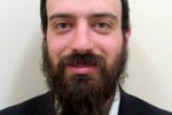Question:
In shul I've noticed that when the torah is raised after the reading has concluded, many people rise and point at the Torah with their pinkies. What's the reason for this peculiar pointing?
Answer:
A mother wants to teach her son what a bird is. She starts by describing to the child in great detail that there's a certain "creature" which has a "beak" and "feathers" and "feet". It even has "wings" which enable it to "fly". Even if she were to get this far without losing his attention, the image of a bird formed in the youngster's mind and what a bird really looks like are likely to be worlds apart. The bird is nothing more than a product of his imagination but in no way part of his reality.
But there's a much simpler way. The mother takes the child outside, points to a bird and says "this is a bird". The boy immediately understands exactly what a bird is and what it does. In a matter of seconds, the bird is not an abstract theoretical concept. In a moment the child has seen that this flying creature is part of his world. For the next few days every time they see a bird, whether in a book or in real-life, the mother reinforces her son's knowledge by making sure to point it out to her child.
Audio/visual presentation is not only for children. Any teacher/lecturer will tell you that this is one of the best ways to teach. In fact, we find a number of times in the Torah where G-d described something to Moses which he was not able to comprehend until G-d showed him what He meant. An example of this is when G-d described to Moses the various non-kosher bugs and insects. Moses found it difficult to understand which insects G-d was referring to, until G-d produced the bug, pointed to it and said "this bug is non-kosher".
The Torah scroll is the holiest item we have today. When one is called to the Torah, the reading of the letters imparts holiness and causes an elevation in the soul of the individual and in the souls of all those connected to him. It is for this reason that being called to the Torah is known as an "Aliya" - literally "ascent". But only a limited amount of people can be called up to read from the Torah. So after the reading the Torah is raised high, giving everyone present an opportunity to gaze at the letters and allow the holiness of the words to enter their souls.
We want to use this opportunity to express what the Torah means to us. We wish to "point out" that the Torah is not an abstract concept, theoretical and distant from us. The Torah is very near to us, part of our reality. It is tangible, pertinent to our daily lives, so much part of our world that we can even point to it. So as the Torah is lifted many point to it and say "and this is the Torah that Moses placed before the Jewish people".
So why the pinkie?
Our sages teach us that the only way that the holiness of the Torah can enter one's soul and become part of one's life is when the approach to Torah is one of humility. A person who feels that they know it all will never allow the sanctity of the Torah to enter one's being and will always remain distant from it. It's for this reason that many use the smallest finger to point, thereby expressing that it's through humility and a willingness to learn that the Torah becomes a tangible part of our lives.
It should be noted that this custom to point at the Torah is merely a custom and like all customs it has been adopted by some communities but not by all.
Wishing you a good Shabbos
 Rabbi Yaacov Chaiton
Rabbi Yaacov Chaiton